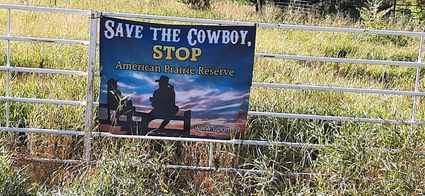Opposing Groups Differ on Their Definitions of the Glory of the West
September 23, 2020
Anyone travelling in North Central Montana has likely seen one of the signs declaring: "Save the Cowboy; Stop the American Prairie Reserve." They are taped to windows, staked in lawns or fields, and tied to fences-like the one on the southeast end of Chinook. This banner announces the conflict between the American Prairie Reserve and the United Property Owners of Montana.
So, what is the American Prairie Reserve (APR)? According to their website, they are a Bozeman-based non-profit business whose mission is "to create the largest nature reserve in the continental United States, a refuge for people and wildlife preserved forever as part of America's heritage."
Working to protect the grassland ecosystem, the APR began to acquire land in 2004. Their main focus is "to purchase and permanently hold title to private lands that glue together a vast mosaic of existing public lands so that the region is managed thoughtfully and collaboratively with state and federal agencies for wildlife conservation and public access."
Since 2004, the APR has completed 31 transactions to build a habitat base of 419,625 acres. By connecting large swaths of fragmented public lands through the strategic purchase of private lands, the APR is assembling a large landscape that forms a patchwork of ownership but is seamless as a prairie ecosystem. APR's overall goal is to stitch together over three million acres of public and private lands to create their reserve. Roughly 20 percent of the land will be privately owned by the APR, and the remaining, approximately 80 percent, will continue as public land.
So far, readers are likely picturing something comparable to a national park. Columnist Parker Heinlein referred to APR's efforts as akin to creating an "American Serengeti" in North Central Montana.
However, these land acquisitions have resulted in the retirement of 63,777 acres of livestock grazing leases in the Charles M. Russell National (CMR) Wildlife Refuge, as well as the elimination of other grazing possibilities in the nature reserve area. As APR purchases ranches, they can also purchase the Bureau of Land Management (BLM) grazing leases on public land attached to them. Because many sheep and cattle ranchers depend on these leases and grazing grounds, they feel undermined and essentially evicted.
Seven Montana counties have an APR presence: Blaine, Phillips, Valley, McCone, Fergus, Petroleum, and Garfield. Ranchers concerned about grazing rights and wildlife encroachment have formed a campaign to stop APR from taking control of that acreage: "Save the Cowboy; Stop the American Prairie Reserve."
Last September, an article by Melody Montgomery ran in the Lewistown News. It pointed out that the signs and banners about saving the cowboy have had one positive effect: People are asking questions.
Deanna Robbins, a rancher in Roy and one of the architects behind the Save the Cowboy banner, stated that the goal behind the banners is to tell people, "Don't be fooled." Robbins is a co-founder of the United Property Owners of Montana (UPOM), a property rights advocacy group hoping to raise awareness. She has partnered with agricultural producers in APR's target region to call attention to "the threat APR poses to the agricultural industry."
APR's Senior External Relations Manager, Beth Saboe claims that "APR has been an easy scapegoat. Most APR land has not been taken out of cattle production to date and is leased to cattle ranchers. We've helped several young cattle ranchers get a start in the business through these leases and have helped others stay in business."
Conversely, UPOM contends that numerous family ranches would be lost. According to Robbins, for many ranchers, APR's effort at creating what they call "the largest nature reserve in the lower 48" would mean either selling out or relocating from that area.
"Trying to run a farm/ranch amidst a growing wildlife reserve would become too burdened by regulations. APR is using their non-profit status to raise millions to buy the private land, often outbidding neighbors who don't have that tax advantage. Their efforts mean that our local communities are losing not only farm and ranch families but also the local businesses they support. It means counties and the state losing taxes from ag production (yes, agriculture IS the number one industry in Montana) that tourism will never replace. It means APR proclaiming to save something that's not endangered," Robbins stated.
She goes on to say, "But maybe what's most important is what APR's efforts don't mean. APR is not creating anything. APR will simply be changing the ownership of the private land from hard working farmers and ranchers, many whose families have toiled for over 100 years to build lives and businesses that feed their families and help feed the world. If APR gets their way, those farms and ranches will be turned into playgrounds for the world's elite and curious. That's it. No new creation, just recreation."
Stay tuned for the rest of the story in next week's (9/30) edition.



